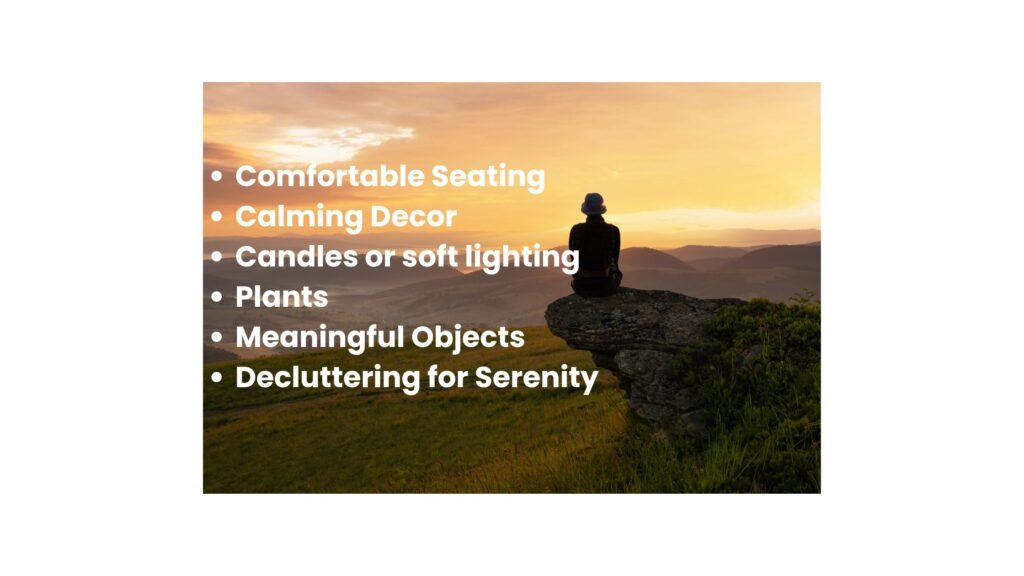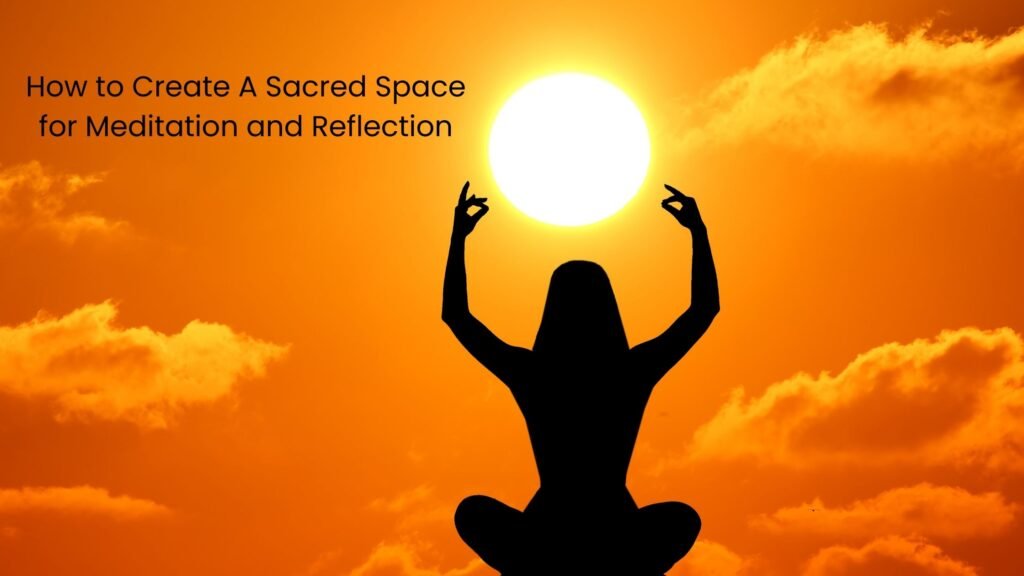Introduction
In today’s fast-paced world, finding moments of stillness can be challenging. Whether you’re practicing meditation, journaling, or simply taking time to breathe, having a dedicated space for reflection can help cultivate a sense of inner peace. A sacred space is more than just a physical area—it’s a personal sanctuary that allows you to disconnect from distractions and reconnect with yourself.
Creating a sacred space for meditation and reflection enhances focus, relaxation, and mindfulness. It provides an environment that encourages stillness, making it easier to quiet the mind and deepen your practice. With the right setup, your space can serve as a powerful reminder to prioritize self-care and spiritual growth. The intentional design of your meditation area, from the lighting and scents to the symbols and decor, can elevate your experience and bring a sense of calm to your daily routine.
In this article, we will guide you through the steps to create your own sacred space, from choosing the right location to incorporating elements that stimulate the senses. We’ll explore essential decor, sensory additions like incense and sound, and daily rituals to maintain the energy of your space. Whether you have an entire room or just a small corner, these simple yet effective tips will help you transform your environment into a peaceful retreat for mindfulness and reflection.
Preparing for Meditation
Setting Up Your Space
Creating a conducive environment is essential for a successful meditation practice. Start by choosing a quiet, peaceful spot where you can sit comfortably without distractions. This could be a cozy corner of your home, a dedicated room, or even a serene outdoor space. Consider using a meditation cushion or chair to support your back and promote good posture, ensuring you can sit comfortably for extended periods.
Keep the room at a comfortable temperature, and consider using a fan or heater if needed to maintain a pleasant atmosphere. Dim the lights or use candles to create a calming ambiance that helps you relax and focus. Removing any electronic devices or distractions from the room is crucial to maintaining a serene environment.
Adding some plants or calming artwork can enhance the peaceful atmosphere of your space. Plants bring a touch of nature indoors, promoting a sense of tranquility, while artwork can provide visual inspiration and a focal point for your meditation practice. By thoughtfully setting up your space, you create an environment that supports mindfulness and deep reflection.
Establishing a Routine
Consistency is key when it comes to developing a meditation practice. Set aside a specific time each day to meditate, such as first thing in the morning or before bed. This helps establish a routine and makes meditation a regular part of your daily life. Starting with a short duration, such as 5-10 minutes, can make it easier to build the habit. As you become more comfortable with the practice, gradually increase the duration of your sessions.
Creating a pre-meditation routine can signal to your mind that it’s time to meditate. Simple rituals like lighting a candle, burning incense, or sipping a cup of tea can help you transition into a meditative state. Making meditation a non-negotiable part of your daily routine, just like brushing your teeth or taking a shower, reinforces its importance and helps you stay committed to your practice.
By establishing a consistent routine, you create a strong foundation for your meditation practice, making it easier to experience the benefits of mindfulness and reflection.
Choosing the Right Location
Selecting the perfect spot for your sacred space is the first step in creating an environment that supports meditation and reflection. The ideal location should be a place where you feel calm, undisturbed, and connected to your inner self.
Find a Quiet, Peaceful Corner – Choose an area in your home that is free from distractions and daily clutter. It could be a spare room, a cozy nook, or even a corner of your bedroom. The key is to have a place where you won’t be interrupted during your practice.
Indoor vs. Outdoor Meditation Spaces – Both indoor and outdoor spaces have unique benefits. An indoor space provides privacy and consistency, allowing you to create a dedicated sanctuary. On the other hand, an outdoor space, such as a garden, patio, or balcony, can help you feel more connected to nature, enhancing relaxation and mindfulness. If you choose an outdoor space, ensure it is comfortable and shielded from excessive noise or weather changes.
Factors to Consider – Pay attention to elements like lighting, noise level, and privacy. Natural light can enhance the energy of your space, but if that’s not available, soft lighting or candles can create a tranquil atmosphere. Try to pick a spot away from loud noises or household activities. Privacy is also crucial—having a space where you can be alone will allow you to fully immerse yourself in meditation and self-reflection.
By choosing the right location, you set the foundation for a sacred space that nurtures mindfulness and inner peace.
Essential Elements of a Sacred Space
Creating a sacred space for meditation and reflection involves incorporating elements that promote comfort, tranquility, and mindfulness. By carefully selecting these elements, you can cultivate a space that helps you feel centered and at peace. Various meditation practices from different spiritual traditions, such as samatha and vipassana in Buddhism, and the role of simran in Sikhism, can be explored in such a space.

By incorporating these essential elements, you can create a sacred space that enhances your meditation practice and nurtures your well-being.
-
Comfortable Seating – A key element of a meditation space is comfortable seating that supports relaxation and focus. Choose from options such as cushions, yoga mats, or meditation chairs to suit your posture and comfort level. If you prefer sitting on the floor, a zafu cushion or a soft mat can provide the necessary support for extended meditation sessions. For those who need extra back support, a meditation bench or ergonomic chair can be a great alternative. Other forms of meditation, such as walking and lying down meditation, have also evolved in Western culture to include both spiritual and secular forms.
-
Calming Decor – The aesthetics of your space should evoke a sense of peace and mindfulness. Simple decorative touches can transform your environment, making it more inviting. Consider adding:
-
Candles or soft lighting to create a warm and soothing ambiance.
-
Plants to bring in fresh energy and a connection to nature.
-
Meaningful objects such as crystals, spiritual symbols, or personal keepsakes that inspire positive energy and reflection.
-
Decluttering for Serenity – A clutter-free space allows for clear thinking and deep relaxation. Remove unnecessary items and keep the area minimal yet meaningful. Storage solutions like baskets or shelves can help maintain order while keeping essential items within reach. A clean, open space will naturally promote a sense of calm and clarity, making it easier to enter a meditative state.
Understanding Meditation
What is Mindfulness Meditation?
Mindfulness meditation is a type of meditation that involves paying attention to the present moment in a non-judgmental way. It’s about cultivating awareness of your thoughts, feelings, and bodily sensations without getting caught up in them. This practice helps you observe your inner experiences with curiosity and openness, allowing you to develop a deeper understanding of yourself.
There are various ways to practice mindfulness meditation, including focusing on the breath, body scan meditation, and loving-kindness meditation. Focusing on the breath involves paying attention to the natural rhythm of your breathing, while body scan meditation guides you through a detailed awareness of different parts of your body. Loving-kindness meditation involves sending positive intentions and compassion to yourself and others.
The goal of mindfulness meditation is to increase self-awareness, reduce stress and anxiety, and improve overall well-being. Regular mindfulness practice can lead to increased gray matter in areas of the brain associated with attention, emotion regulation, and memory. Additionally, mindfulness meditation can be integrated into daily activities, such as eating, walking, or showering, to enhance awareness and presence in every moment.
By understanding and practicing mindfulness meditation, you can cultivate a greater sense of peace, clarity, and connection in your daily life.
Incorporating Senses for a Deeper Experience
Engaging all five senses in your meditation space can enhance mindfulness and create a more immersive, calming experience. By incorporating elements that appeal to sight, sound, smell, and touch, you can transform your sacred space into a sanctuary for inner peace and reflection.
Sight: Visual elements play a significant role in setting the tone for relaxation.
Use soft, natural lighting with candles or Himalayan salt lamps to create a warm ambiance.
Use soothing shades such as soft blues, greens, or earthy tones to create a tranquil atmosphere.
Display visual inspiration such as spiritual art, mandalas, or nature imagery to encourage introspection and positive energy.
Sound: Soothing sounds can help clear the mind and deepen relaxation.
Play gentle meditation music, Tibetan singing bowls, or nature sounds (rain, ocean waves, birds chirping).
Use a small water fountain to add a calming background sound of flowing water.
Experiment with chanting or guided meditation recordings for added focus.
Smell: Aromatherapy can have a powerful effect on mood and relaxation.
Diffuse essential oils like lavender, sandalwood, or frankincense for a soothing atmosphere.
Burn incense or sage to cleanse the space and promote clarity.
Light naturally scented candles to create a warm, inviting ambiance.
Touch: Grounding through tactile sensations enhances the feeling of comfort and connection.
Use soft blankets or meditation cushions for warmth and coziness.
Hold crystals, smooth stones, or mala beads to enhance focus and deepen meditation.
Place a textured rug or natural floor mat for a grounding experience.
By engaging these senses, your sacred space becomes a sanctuary that supports relaxation, mindfulness, and spiritual connection, making every meditation session more meaningful.
Personalizing Your Sacred Space
Creating a sacred space is not just about design—it’s about making it uniquely yours. By adding personal touches that reflect your spiritual journey, values, and intentions, you can create a place that truly resonates with your energy. Here are a few ways to infuse your personality and beliefs into your meditation space:
Incorporate Spiritual or Meaningful Symbols
Display statues or figurines of deities, spiritual guides, or symbols that inspire you.
Write down or frame positive affirmations, mantras, or sacred texts to encourage mindfulness and motivation.
Use vision boards or meaningful artwork that aligns with your intentions.
Create an Altar with a Reflecting Surface
An altar can be a focal point for meditation, gratitude, or intention-setting.
Prayer can significantly enhance spiritual practices, offering a means to connect with the divine and deepen your meditation experience.
Arrange candles, flowers, or personal objects that hold sentimental value.
Add crystals, stones, or sacred relics that resonate with your spiritual practice.
Incorporate Mindfulness Tools
Keep a journal nearby for writing down reflections, affirmations, or gratitude lists.
Use oracle or tarot cards for daily guidance and inspiration.
Integrate meditation apps or guided sessions to deepen your practice.
Personalizing your sacred space makes it a place where you feel safe, inspired, and deeply connected to your spiritual and mindfulness journey. Whether big or small, let your sacred space be a reflection of your soul.
Daily Rituals to Maintain Your Sacred Space
Setting intentions before mindfulness meditation
Setting intentions before meditating helps create clarity, focus, and purpose for your practice. Reflecting on your intentions emphasizes the importance of introspection and contemplation, directing your energy toward a specific goal—whether it’s finding inner peace, cultivating gratitude, releasing stress, or enhancing self-awareness. Intentions act as a guiding force, keeping your mind aligned with your desired outcome rather than wandering aimlessly. They also help strengthen mindfulness by reminding you to stay present and connected to your purpose. Over time, regularly setting intentions can deepen your meditation practice, making it more meaningful and transformative. Whether spoken aloud, written down, or silently affirmed, an intention anchors your thoughts, emotions, and energy, allowing you to meditate with greater purpose and awareness.
Keeping the space clean and energetically fresh
A sacred space should feel calm, uplifting, and free from distractions, which is why keeping it clean and energetically fresh is essential. A cluttered or dusty space can create mental fog and disrupt the flow of positive energy. Regularly dusting, vacuuming, and organizing the area ensures a clear and inviting atmosphere for meditation and reflection. Beyond physical cleanliness, energetic cleansing is just as important. Smudging with sage, palo santo, or incense can help remove stagnant energy, while using sound healing tools like singing bowls or bells can refresh the space vibrationally. Opening windows to let in fresh air and natural light also revitalizes the energy in the room. By maintaining a clean and energetically balanced space, you create a sanctuary that supports mindfulness, relaxation, and spiritual growth.
Using rituals like lighting a candle, burning incense, or reciting affirmations.
Incorporating rituals into your meditation and reflection practice can create a sense of intention, presence, and sacredness. Simple acts like lighting a candle, burning incense, or reciting affirmations help signal to the mind and body that it’s time to slow down, focus, and enter a peaceful state. The soft glow of a candle can symbolize inner light and clarity, while incense or essential oils can stimulate the senses, promoting relaxation and grounding. Reciting affirmations or mantras reinforces positive energy and helps set intentions, aligning your thoughts with your spiritual or personal growth journey. These small yet powerful rituals create a structured practice, enhancing mindfulness, deepening spiritual connection, and fostering a tranquil atmosphere for self-reflection and inner peace.
Recommended Products to Enhance Your Space
Meditation Cushions and Mats
Investing in a comfortable meditation cushion or mat can significantly improve your practice by providing proper support and posture alignment. Sitting for extended periods can cause discomfort, but a cushion (zafu) or a supportive mat ( zabuton) helps reduce strain on the hips, knees, and lower back, allowing you to meditate with ease and relaxation.
Benefits of Using Meditation Cushions and Mats:
Better Posture: Supports the natural curve of the spine and promotes a stable sitting position.
Enhanced Comfort: Reduces pressure on joints, making longer meditation sessions more comfortable.
Grounding and Focus: Having a dedicated cushion or mat signals to your mind that it’s time to be present and mindful.
When choosing a meditation cushion or mat, look for ergonomic designs, organic or eco-friendly materials, and durability. Some cushions come with adjustable filling for customized comfort, while mats provide extra cushioning for those who prefer meditating on the floor. Whether you practice mindfulness, breathwork, or deep reflection, having the right support can make a big difference in your meditation experience.
Essential Oil Diffusers and Incense
Creating a sacred space for meditation and reflection can be elevated with the right ambiance, and essential oil diffusers and incense are two powerful tools to enhance the experience.
Essential Oil Diffusers – Diffusing essential oils like lavender, sandalwood, or frankincense can help promote calmness, clarity, and relaxation during meditation. Ultrasonic diffusers disperse the oils into the air, creating a soothing atmosphere that engages the senses.
Incense – Burning incense sticks or cones made from natural resins and herbs can aid in deepening focus, purifying energy, and uplifting the spirit. Scents like sage, myrrh, and palo santo are traditionally used for clearing negative energy and enhancing mindfulness.
Both of these tools can serve as ritualistic elements, signaling the mind that it’s time to disconnect from distractions and enter a peaceful state. Whether you prefer the gentle mist of essential oils or the grounding scent of incense, these additions will transform your meditation space into a sanctuary of serenity.
Singing Bowls, Chimes, and Sound Healing Tools
Sound plays a crucial role in creating a harmonious and calming atmosphere for meditation and reflection. Incorporating singing bowls, chimes, or other sound healing tools into your sacred space can help enhance focus, reduce stress, and promote deep relaxation.
Singing Bowls – Tibetan or crystal singing bowls produce soothing vibrations that help balance energy, clear the mind, and promote emotional healing. They are ideal for deep meditation or sound therapy practices.
Chimes – Wind chimes or hand chimes create gentle, melodic sounds that enhance tranquility and mindfulness. Their soft tones can be used to signal the beginning or end of a meditation session.
Tuning Forks – These tools emit specific frequencies that aid in grounding, relaxation, and emotional balance. They can be used alongside other sound healing practices to deepen your meditation experience.
Gongs or Drums – Larger sound healing instruments, such as gongs or meditation drums, provide powerful sound waves that promote energy flow, clear negativity, and restore balance in your space.
Integrating these sound healing tools into your meditation routine can elevate your practice, helping you achieve greater focus, inner peace, and a deeper connection to yourself. Additionally, these tools can facilitate a sense of connection to God, enhancing the spiritual aspect of your meditation.
Spiritual books, journals, or affirmation cards.
Creating a peaceful and inspiring meditation space can be enhanced with spiritual books, journals, and affirmation cards that support mindfulness and self-reflection. Here are some essential items to consider:
Spiritual Books – Reading about mindfulness, spirituality, or self-growth can deepen your practice. Look for books on meditation, gratitude, or ancient wisdom to inspire your journey. Additionally, consider exploring the role of prayers within various religious traditions, particularly how meditation is intertwined with prayer practices in Judaism, Christianity, and Islam.
Journals – A beautiful journal can be used for writing reflections, setting intentions, or tracking personal growth. Journaling after meditation helps process emotions and gain clarity.
Affirmation Cards – Using affirmation or oracle cards allows you to draw daily inspiration, set positive intentions, and cultivate a peaceful mindset. These cards can serve as a guiding tool during meditation and reflection.
By incorporating these products into your space, you create an environment that nurtures your mind, body, and spirit, making your meditation practice more meaningful and effective.
Conclusion
Creating a sacred space for meditation and reflection is a powerful way to cultivate inner peace, mindfulness, and spiritual growth. A dedicated space allows you to disconnect from distractions, focus on your intentions, and create a calming environment that supports deep relaxation and self-awareness.
By incorporating comfortable seating, soothing decor, sensory elements, and personal touches, you can transform any corner of your home into a peaceful retreat. Making this space part of your daily routine helps build consistency in your meditation and self-care practices.
Now is the perfect time to start designing your sacred space! Explore our recommended products, such as spiritual books, journals, and affirmation cards, to enhance your meditation experience and deepen your connection with yourself. Whether you’re just beginning or looking to elevate your practice, creating a sacred space will bring balance, clarity, and serenity into your daily life.




